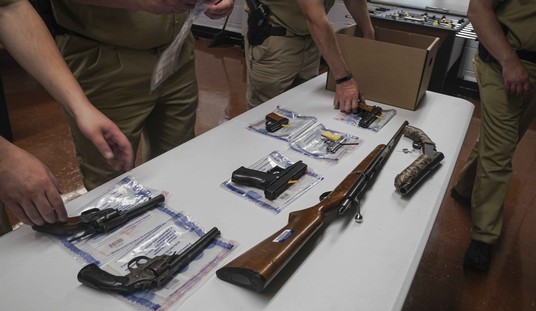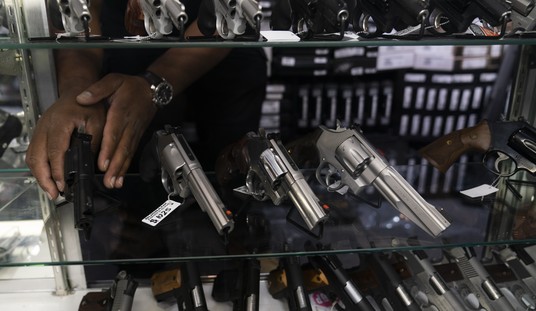Like virtually everything else under the sun, the cost of brass has been increasing over the past few years, which has not only causd the price of casings for reloaders to go up, but has made selling brass a more attractive proposition for some folks.
If you’ve got pounds and pounds of casings sitting around, you could probably put some cash in your pocket by selling them to your local gun store, but I don’t recommend trying to acquire brass on the cheap to re-sell… especially if it involves collecting spent casings from a range where U.S. Army helicopter crews routinely hold target practice.
The thief, wearing camouflage gear and gloves, crept through the woods onto the Army base in southern Alabama where most of the U.S. military’s helicopter pilots train. His objective: Collecting sandbags he had filled with used 30 mm brass shell casings from the attack helicopters flying and firing over the base’s range during practice missions.
With the value of scrap brass rising – and each round of 30 mm ammunition longer than an adult’s outstretched hand – every haul of loaded sandbags could have been worth thousands of dollars. It had been harvested from an area on Fort Rucker off-limits to civilians. It’s the latest in a long string of thefts of increasingly valuable brass from American military bases across the country, a problem that has plagued the armed services since the early 2000s.
In this case, Army criminal investigators believe their suspect stole nearly $40,000 worth of ammunition brass over months but accidentally left behind clues to his identity pointing back to Florida: two Gatorade bottles with trace amounts of DNA.
The theft of the brass was originally discovered last year when six sandbags full of the brass casings were discovered off of a trail inside the military base.
The brass casings are used during Army pilot training on Boeing AH-64 Apache attack helicopters, said Jimmie E. Cummings Jr., director for public affairs at Fort Rucker, where all Army and Air Force helicopter pilots are trained.
“The Apache is the Army’s gunship,” said Cummings. “So, when our Apaches fire during their training where they learn to engage charges from the helicopter, all these casings fall to the ground in the impact area.”
Those areas at Fort Rucker are off limits to the public and are secured by gates with signs warning that no one is allowed to enter by order of the base’s commanding officer, Cummings said.
In the same area as the sandbags full of spent casings, investigators also found a non-military grade camouflage backpack that contained a camouflage long-sleeve shirt, a pair of leather gloves and a pair of cloth gloves. Next to the backpack lay the two Gatorade bottles.
The DNA evidence found on the Gatorade bottles allegedly led military investigators to 44-year old Eric Lee Culpepper, Sr., who lives about 80 miles from Fort Rucker. Court documents reveal a military investigator says that the DNA on the bottles belongs to Culpepper, though he has not been charged in the thefts.
The court documents were filed in U.S. District Court for the Northern District of Florida under a name and a case number with no obvious references to Culpepper, who was separately identified on sheriff’s arrest warrants as a former grave digger and construction framer.
Investigators said Culpepper pawned an estimated eight tons of ammunition brass at a scrap metal recycling company for $37,242 between February and October last year, court records said. The Army said it otherwise would have paid a vendor to collect the brass casings from the range for its own recycling.
Culpepper has not been charged in the ammunition brass thefts in Alabama, even though four months have passed since investigators collected fresh DNA from Culpepper to compare against the crime scene. It took roughly the same amount of time after investigators submitted the Gatorade bottles for the lab scientists to report a match to Culpepper’s DNA.
Why hasn’t Culpepper been formally charged if investigators believe he’s the man responsible for the theft? Well, no one’s quite sure, and neither the U.S. Army or federal prosecutor listed in the court documents are saying anything. Given the weight of the evidence (no pun intended), though, it would seem that Culpepper is going to be formally charged at some point… but at the moment there are several other legal issues for him to deal with.
The Okaloosa County Sheriff’s Office confirmed this week it also was looking to find Culpepper to arrest him after he failed to appear in circuit court in January for a misdemeanor case accusing him of violating a domestic violence protection order that had been in place since 2017. Court officials separately suspended his driver’s license in August over an unpaid $47.60 traffic violation.
In neighboring Santa Rosa County, Culpepper pleaded no contest earlier this month in an unrelated case to felony and misdemeanor drug and traffic charges, after a sheriff’s deputy said he found a small amount of methamphetamine and a syringe in his car during a traffic stop in December. Circuit Judge Darlene Fallon Dickey withheld adjudication on the felony drug charge and sentenced him to jail time he had already served of two months and 24 days, plus two years’ probation, court records showed.
Apparently Culpepper hasn’t been seen (at least by authorities) since he was released earlier this month after being sentenced to time served. If he is formally charged in connection with the stolen brass, that could result in his being sentenced on the felony drug charges from Florida as well as having to answer for his alleged crimes in federal court.
$40,000 (or close to it) is a pretty good payday, but stealing from Uncle Sam, even it’s spent brass, is likely to cost you far more in the long run, including your freedom. We’ll be keeping an eye out for any updates on this case, and we’ll let you when and if any charges are ever levied against Culpepper or anyone else in connection with the case of the missing brass.









